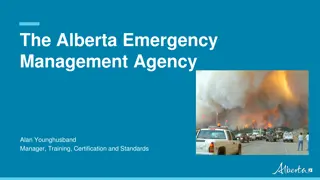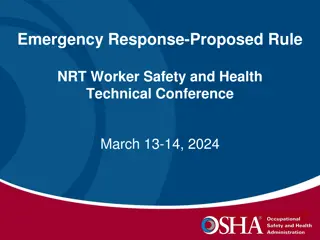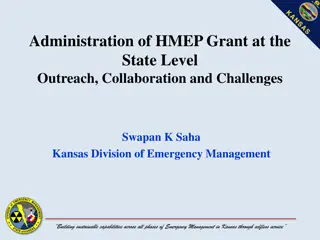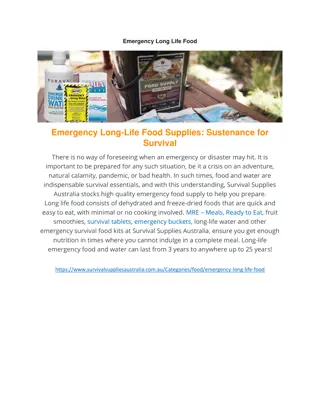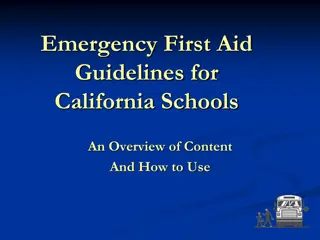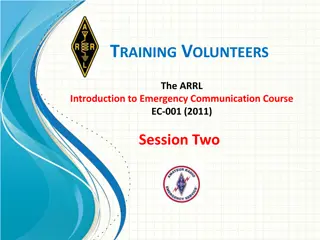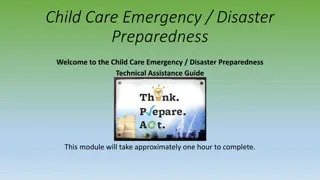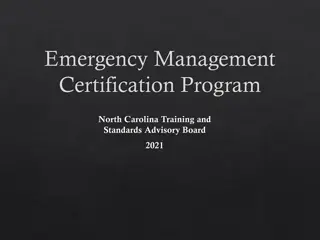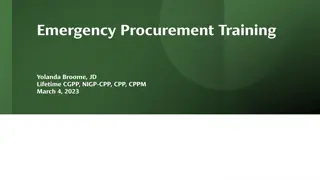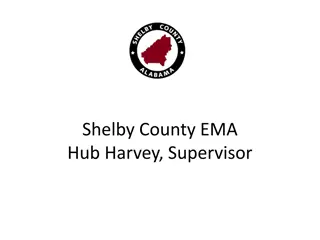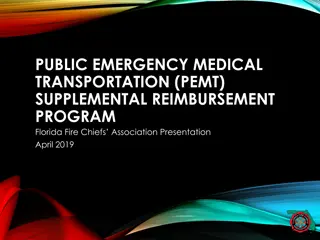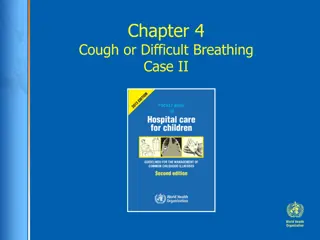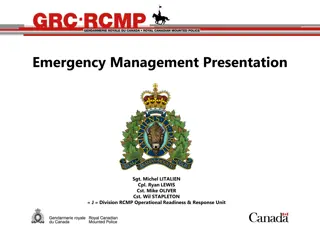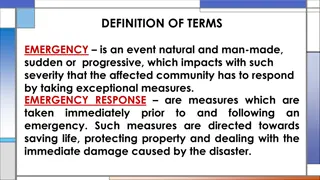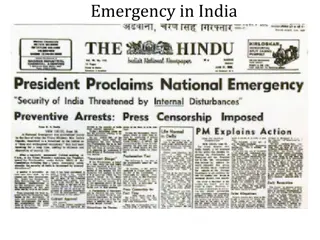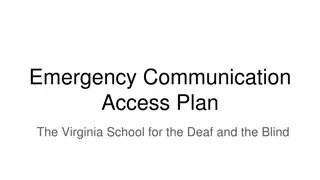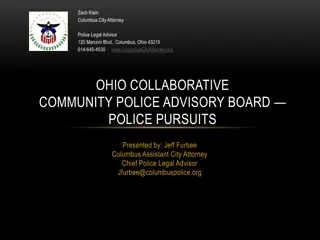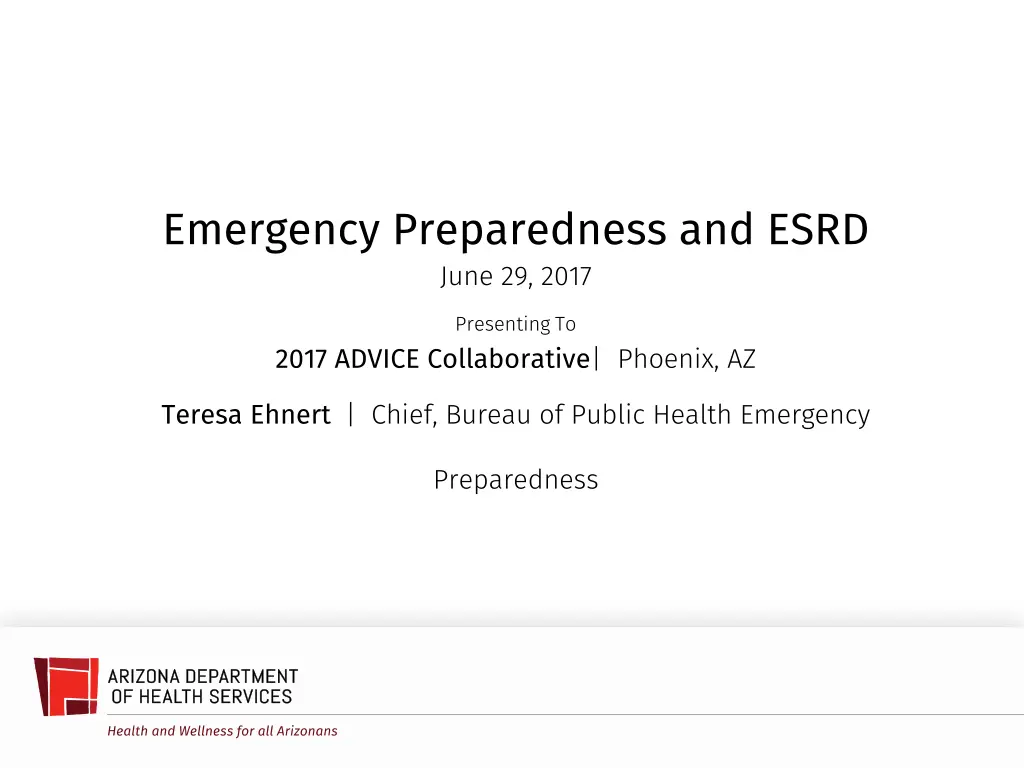
Empowering Disaster Preparedness: Understanding Electricity Dependency in ESRD Patients
Learn about the critical role of electricity for over 2.5 million ESRD patients in the U.S. and how the emPOWER initiative aids in disaster response planning by providing valuable data at a local level. Discover the significance of preparedness for electricity-dependent populations during power outages and emergencies.
Download Presentation

Please find below an Image/Link to download the presentation.
The content on the website is provided AS IS for your information and personal use only. It may not be sold, licensed, or shared on other websites without obtaining consent from the author. If you encounter any issues during the download, it is possible that the publisher has removed the file from their server.
You are allowed to download the files provided on this website for personal or commercial use, subject to the condition that they are used lawfully. All files are the property of their respective owners.
The content on the website is provided AS IS for your information and personal use only. It may not be sold, licensed, or shared on other websites without obtaining consent from the author.
E N D
Presentation Transcript
Emergency Preparedness and ESRD June 29, 2017 Presenting To 2017 ADVICE Collaborative| Phoenix, AZ Teresa Ehnert | Chief, Bureau of Public Health Emergency Preparedness
Agenda Review Empower data and how it applies to ESRD patients and facilities Provide an overview of the Arizona Crisis Standards of Care Plan and how it applies to ESRD patients
What is electricity dependency? Over 2.5 million people in the United States rely on electricity dependent medical and assistive equipment to live independently in their homes Ventilators Wheelchairs, to live independently in their ESRD equipment Etc.
Power Outages Natural and man-made disasters that cause prolonged power outages can be life threatening to these individuals. Severe weather Wildfires Technology failures Cyber attacks Etc.
What is emPOWER? The Office for the Assistant Secretary for Preparedness and Response (ASPR) in partnership with the Centers for Medicare and Medicaid Services (CMS) launched emPOWER to help community partners better anticipate, plan for, and respond to the needs of electricity dependent populations. Source: HHS emPOWER Map Fact Sheet
What is emPOWER Continued? It is an interactive map that provides monthly de- identified Medicare data -down to the zip code level- and an expanded set of near real-time hazard tracking services. Together, this information provides enhanced situational awareness and actionable information for assisting areas and at-risk populations that may be impacted by disasters. Source: HHS emPOWER Map Fact Sheet
What is emPOWER Continued? HHS emPOWER Initiative - April 2017 Update De-Identified Aggregated U.S. County Services Services Services All Power Dependent Cardiac Device, Ventilator, BiPAP, Oxygen Concentrator, Enteral Feeding, IV Infusion Pump, Suction Pump, At-Home ESRD, Motorized Wheelchair, Scooter, or Electric Bed In-Facility ESRD (3 months) Oxygen Services [Tanks] (13 months) Home Health (3 months) # Medicare Beneficiaries in County # Beneficiary Addresses (Excludes P.O. Boxes and Unknowns) # Electricity- Dependent Devices and DME County FIPS Code State FIPS Code # Zip Codes in County # In-Facility ESRD Dialysis # Masked Zip Codes in County # O2 Services [Tanks] # Masked Zip Codes in County # Masked Zip Codes in County # Masked Zip Codes in County County State # Home Health 001 Apache 04 AZ 16 9,555 567 244 9 407 6 132 12 788 5 003 Cochise 04 AZ 19 27,213 21,208 189 11 574 8 302 8 1,753 5 005 Coconino 04 AZ 22 15,003 9,413 172 8 590 13 356 11 1,397 7 007 Gila 04 AZ 10 14,850 9,618 141 6 446 6 219 5 1,155 3 009 Graham 04 AZ 6 5,037 3,465 50 3 187 3 96 3 343 2 011 Greenlee 04 AZ 4 1,146 498 33 3 41 2 22 2 81 2 012 La Paz 04 AZ 6 4,878 1,818 76 3 154 2 87 2 291 0 013 Maricopa 04 AZ 134 583,161 555,593 3,053 38 8,741 8 8,440 11 23,162 5 015 Mohave 04 AZ 23 56,808 48,827 269 8 1,753 7 801 9 3,633 5 017 Navajo 04 AZ 23 19,540 8,411 296 14 901 10 172 11 2,147 6 019 Pima 04 AZ 46 192,631 181,076 1,015 16 2,588 4 2,173 6 8,073 3 021 Pinal 04 AZ 24 61,174 51,904 546 12 984 10 922 9 2,578 4 023 Santa Cruz 04 AZ 7 7,819 5,371 98 3 134 5 67 5 277 3 025 Yavapai 04 AZ 27 69,102 56,266 225 16 2,027 4 1,188 9 5,773 2 027 Yuma 04 AZ 10 29,640 23,179 223 3 349 4 614 4 955 3
Arizona emPOWER Data (June 2017) COUNTY Apache Cochise Coconino Gila Graham Greenlee La Paz Maricopa Mohave Navajo Pima Pinal Santa Cruz Yavapai Yuma TOTAL In-Facility ESRD Dialysis 244 189 172 141 50 33 76 3,053 269 296 1,015 546 98 225 223 6,630 At-Home ESRD Dialysis 110 99 55 55 44 11 0 1,089 154 143 352 154 22 77 85 2,450
Arizona emPOWER Data (June 2017) COUNTY Apache Cochise Coconino Gila Graham Greenlee La Paz Maricopa Mohave Navajo Pima Pinal Santa Cruz Yavapai Yuma TOTAL Electricity Dependent 788 1,753 1,397 1,155 343 81 291 23,162 3,633 2,147 8,073 2,578 277 5,773 955 52,406 Includes: Cardiac Device, Ventilator, BiPAP, Oxygen Concentrator, Enteral Feeding, IV Infusion Pump, Suction Pump, At- Home ESRD, Motorized Wheelchair, Scooter, or Electric Bed
Data Source The CMS dataset is developed from Medicare Fee For Service (FFS) Part A and B beneficiary administrative claims data (~32M 65+, blind, ESRD (dialysis), dual-eligible, disabled-can include adults and children) and Medicare Advantage claims data (~17M 65+, blind, ESRD (dialysis), dual-eligible, disabled-can include adults and children). This data does not include individuals that are only enrolled in a State Medicaid Program.
Arizona Crisis Standards of Care (CSC) Plan The purpose of this plan is to provide clear and consistent guidance for allocating scarce healthcare resources during a catastrophic disaster.
CSC and the State Disaster Medical Advisory Committee (SDMAC) During a catastrophic public health emergency, the SDMAC will convene to develop guidance for the allocation of scarce medical resources (space, staff, and supplies)
Indicators for statewide CSC Activation One or more counties/regions request state to implement CSC Medical countermeasures depleted Patient transfers insufficient or impossible statewide County resource requests unfillable or undeliverable Multiple healthcare access points impacted
CSC Challenges SDMAC guidance must balance the needs of disaster victims with chronically ill and other at- risk populations.
Dialysis resources may be stressed by: Increased demand for services Damage to healthcare infrastructure Shortages in staff and supplies Power outages Etc.
Facility-Level Disaster Plans What can an effective disaster plan do for your facility? Promote safety for staff and patients Help ensure continuity of care for vulnerable populations Improve coordination and communication with response organizations (public health, emergency management, first responders, etc.)
CMS-NEW PREPAREDNESS RULES EMERGENCY PREPAREDNESS GUIDANCE AND END STAGE RENAL DISEASES (ESRD)
Emergency Plan The dialysis facility must develop and maintain an emergency preparedness plan that must be evaluated and updated at least annually. The plan must do all of the following: 1) Be based on and include a documented, facility- based and community-based risk assessment, utilizing an all-hazards approach. 2) Include strategies for addressing emergency events identified by the risk assessment.
Emergency Plan Continued 3) Address patient population, including, but not limited to, the type of services the dialysis facility has the ability to provide in an emergency; and continuity of operations, including delegations of authority and succession plans.
Emergency Plan Continued 4) Include a process for cooperation and collaboration with local, tribal, regional, State, and Federal emergency preparedness officials' efforts to maintain an integrated response during a disaster or emergency situation, including documentation of the dialysis facility's efforts to contact such officials and, when applicable, of its participation in collaborative and cooperative planning efforts.
Emergency Plan Continued 5) The dialysis facility must contact the local emergency preparedness agency at least annually to confirm that the agency is aware of the dialysis facility's needs in the event of an emergency.
Communications Plan The dialysis facility is required to develop and maintain an emergency preparedness communication plan that complies with Federal, State, and local laws and must be reviewed and updated at least annually. The communication plan must include all of the following:
Communications Plan Continued 1) Names and contact information for the following: 1. Staff. 2. Entities providing services under arrangement. 3. Patients' physicians. 4. Other dialysis facilities. 5. Volunteers.
Communications Plan Continued 2) Contact information for the following: 1. Federal, State, tribal, regional or local emergency preparedness staff. 2. Other sources of assistance.
Communications Plan Continued 3) Primary and alternate means for communicating with the following: 1. Dialysis facility's staff. 2. Federal, State, tribal, regional, or local emergency management agencies.
Communications Plan Continued 4) A method for sharing information and medical documentation for patients under the dialysis facility's care, as necessary, with other health care providers to maintain the continuity of care. 5) A means, in the event of an evacuation, to release patient information as permitted under 45 CFR 164.510(b)(1)(ii).
Communications Plan Continued 6) A means of providing information about the general condition and location of patients under the facility's care as permitted under 45 CFR 164.510(b)(4). 7) A means of providing information about the dialysis facility's needs, and its ability to provide assistance, to the authority having jurisdiction or the Incident Command Center, or designee.
THANK YOU Teresa Ehnert | Chief, Bureau of Public Health Emergency Preparedness Teresa.ehnert@azdhs.gov | 602-364-3571 azhealth.gov @azdhs facebook.com/azdhs

